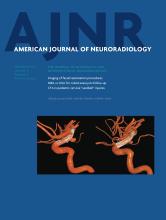Research ArticleInterventional
Effect of Structural Remodeling (Retraction and Recoil) of the Pipeline Embolization Device on Aneurysm Occlusion Rate
L.-D. Jou, B.D. Mitchell, H.M. Shaltoni and M.E. Mawad
American Journal of Neuroradiology September 2014, 35 (9) 1772-1778; DOI: https://doi.org/10.3174/ajnr.A3920
L.-D. Jou
aFrom the Departments of Radiology (L.-D.J., H.M.S., M.E.M.)
B.D. Mitchell
bNeurosurgery (B.D.M.), Baylor College of Medicine, Houston, Texas.
H.M. Shaltoni
aFrom the Departments of Radiology (L.-D.J., H.M.S., M.E.M.)
M.E. Mawad
aFrom the Departments of Radiology (L.-D.J., H.M.S., M.E.M.)

REFERENCES
- 1.↵
- Crobeddu E,
- Lanzino G,
- Kallmes DF,
- et al
- 2.↵
- Kan P,
- Siddiqui AH,
- Veznedaroglu E,
- et al
- 3.↵
- McAuliffe W,
- Wycoco V,
- Rice H,
- et al
- 4.↵
- Saatci I,
- Yavuz K,
- Ozer C,
- et al
- 5.↵
- Nelson PK,
- Lylyk P,
- Szikora I,
- et al
- 6.↵
- Yu SC,
- Kwok CK,
- Cheng PW,
- et al
- 7.↵
- Kulcsár Z,
- Houdart E,
- Bonafe A,
- et al
- 8.↵
- Cruz JP,
- Chow M,
- O'Kelly C,
- et al
- 9.↵
- King RM,
- Chueh JY,
- van der Bom IM,
- et al
- 10.↵
- 11.↵
- Clarençon F,
- Piotin M,
- Pistocchi S,
- et al
- 12.↵
- Valdivia y Alvarado M,
- Ebrahimi N,
- Benndorf G
- 13.↵
- Heran NS,
- Song JK,
- Namba K,
- et al
- 14.↵
- Chalouhi N,
- Tjoumakaris SI,
- Gonzalez LF,
- et al
- 15.↵
- Fischer S,
- Vajda Z,
- Aguilar Perez M,
- et al
- 16.↵
- 17.↵
- Mut F,
- Cebral JR
- 18.↵
- Ebrahimi N,
- Claus B,
- Lee CY,
- et al
- 19.↵
- Duda SH,
- Wiskirchen J,
- Tepe G,
- et al
- 20.↵
- Wang R,
- Ravi-Chandar K
- 21.↵
- Aziz S,
- Morris JL,
- Perry RA,
- et al
- 22.↵
- 23.↵
- Tanimoto S,
- Bruining N,
- van Domburg RT,
- et al
- 24.↵
- Berrocal DH,
- Gonzalez GE,
- Fernandez A,
- et al
- 25.↵
- Colby GP,
- Lin LM,
- Gomez JF,
- et al
- 26.↵
- Lylyk P,
- Miranda C,
- Ceratto R,
- et al
- 27.↵
In this issue
American Journal of Neuroradiology
Vol. 35, Issue 9
1 Sep 2014
Advertisement
L.-D. Jou, B.D. Mitchell, H.M. Shaltoni, M.E. Mawad
Effect of Structural Remodeling (Retraction and Recoil) of the Pipeline Embolization Device on Aneurysm Occlusion Rate
American Journal of Neuroradiology Sep 2014, 35 (9) 1772-1778; DOI: 10.3174/ajnr.A3920
0 Responses
Jump to section
Related Articles
Cited By...
- Braid stability after flow diverter treatment of intracranial aneurysms: a systematic review and meta-analysis
- Braids and beyond: a comprehensive study on pipeline device braid stability from PREMIER data
- Wall Apposition Is a Key Factor for Aneurysm Occlusion after Flow Diversion: A Histologic Evaluation in 41 Rabbits
This article has been cited by the following articles in journals that are participating in Crossref Cited-by Linking.
- Krishnan Ravindran, Amanda M Casabella, Juan Cebral, Waleed Brinjikji, David F Kallmes, Ram KadirvelNeurosurgery 2020 86 Supplement_1
- A. Rouchaud, C. Ramana, W. Brinjikji, Y.-H. Ding, D. Dai, T. Gunderson, J. Cebral, D.F. Kallmes, R. KadirvelAmerican Journal of Neuroradiology 2016 37 11
- Liang-Der Jou, Gouthami Chintalapani, Michel E MawadInterventional Neuroradiology 2016 22 1
- Naci Kocer, Prabath Kumar Mondel, Elif Yamac, Ayse Kavak, Osman Kizilkilic, Civan IslakNeuroradiology 2017 59 11
- Hannes Luecking, Arnd Doerfler, Philipp Goelitz, Philip Hoelter, Tobias Engelhorn, Stefan LangInterventional Neuroradiology 2020 26 1
- Gouthami Chintalapani, Ponraj Chinnadurai, Visish Srinivasan, Stephen R. Chen, Hashem Shaltoni, Hesham Morsi, Michel E. Mawad, Peter KanEuropean Journal of Radiology 2016 85 7
- Santiago Ortega-Gutierrez, Aaron Rodriguez-Calienes, Juan Vivanco-Suarez, H Saruhan Cekirge, Ricardo A Hanel, Mahmoud Dibas, Saleh Lamin, Hal Rice, Isil Saatci, David Fiorella, Pedro Lylyk, Feyyaz Baltacioglu, Ivan Lylyk, Vitor Mendes Pereira, Matthew J Gounis, Jens FiehlerJournal of NeuroInterventional Surgery 2025 17 3
- Michael Karsy, Jian Guan, Andrea A. Brock, Anubhav Amin, Min S. ParkCurrent Neurology and Neuroscience Reports 2017 17 12
- Samuel D. Pettersson, MirHojjat Khorasanizadeh, Benton Maglinger, Alfonso Garcia, S. Jennifer Wang, Philipp Taussky, Christopher S. OgilvyWorld Neurosurgery 2023 178
- Sandeep Muram, Muneer Eesa, Brooke L. Belanger, Mohammed Almekhlafi, Mayank Goyal, William Morrish, John H. Wong, Santiago Gomez-Paz, Yosuke Akamatsu, Mohamed M. Salem, Timothy M. Robinson, Justin M. Moore, Ajith J. Thomas, Christopher S. Ogilvy, Alim P. MithaWorld Neurosurgery 2021 145
More in this TOC Section
Similar Articles
Advertisement











